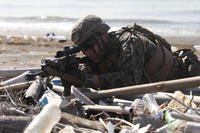Caps on defense spending limit training, force service members to use old gear and may lead to an exodus of troops from the armed services, the four service chiefs told lawmakers Thursday.
Speaking before the Senate Armed Services Committee, the leaders of the Army, Navy, Air Force and Marine Corps warned that a return of sequestration budget caps would promote fiscal uncertainty and take a deep toll on rank-and-file morale.
The Bipartisan Budget Act of 2015 put a temporary stay on a half-trillion dollar tranche of defense budget cuts, but the armed services must plan around the reductions for five more years if Congress does not again act to avert them.
For the Navy and Marine Corps, limited funding and delayed aircraft modernization have resulted in limited pilot flight hours. This summer, the Marine Corps resorted to an unusual measure, pulling 30 F/A-18C Hornets from the "boneyard" at Davis-Monthan Air Force Base in Arizona and putting them back into service in an effort to maintain readiness ahead of F-35B Joint Strike Fighters entering the fleet in numbers.
"When our pilots are flying less hours a month than Russian and Chinese pilots are, we're going to have a problem," Sen. John McCain, a Republican from Arizona who heads the defense committee, told the generals.
The chief of naval operations said limited flight hours also take a toll on morale.
"Our pilots join the Navy to fly naval aircraft; that's what they want to do," Adm. John Richardson said. "Money can help up to a point … but at the heart of the matter, there is a highly dedicated team that wants to defend the nation in high-performance aircraft, and that's what they want to do: They want to fly."
Gen. Robert Neller, commandant of the Marine Corps, said aircraft maintainers and aircrew were also at risk of being lost to commercial aviation companies and contractors as the service is forced to cannibalize parts and require staff to maintain productivity with fewer resources.
"We're making it now on the backs of those sergeants and staff sergeants out there that have to do work twice to get the part we want and put it on another [aircraft]," he said. "So I'm as concerned about maintainers sticking around."
Gen. David Goldfein, Air Force chief of staff, said readiness and morale are inextricably linked for the service, and airmen who are not being used to their full potential will look for other opportunities.
"Pilots who don't fly, maintainers who don't maintain, controllers who don't control, will walk," he said. "And there's not enough money in the treasury to keep them in if we don't give them enough resources to keep investing."
Without reliable money to modernize, Goldfein said the service has had to lean heavily on Service Life Extension Programs to make its aging aircraft last longer -- an expensive and risky endeavor, he said.
"There's a reason [SLEP is] a four-letter word," he said. "The reality is, we only fix what we can accurately predict. Then we put the aircraft into depot maintenance, we pull the skin off, and what we find are things breaking that we never predicted."
With the service's F-15C Eagle, a steering problem fix turned out to require a part that hadn't been manufactured in five years. The Air Force was forced to commission new parts at significant cost.
The chief of staff of the Army, Gen. Mark Milley, said sequestration cuts would undercut plans to ramp up training for high-end threats, which had fallen off during the last 15 years of war in Iraq and Afghanistan.
"An armor officer today -- a tank officer up through rank of major -- has very little experience in terms of maneuvering tanks against an opponent who has armor," he said. "We have to rebuild that. That's going to take considerable time and effort on our part. Sequestration will take the rug out from underneath us."
Sen. Lindsey Graham, a Republican from South Carolina, said he found the lack of action in the face of troubling defense budget concerns "repugnant." With the return of sequestration, he confirmed with the service chiefs, some 30 ships would not be added to the Navy's fleet and the Army would lose between 60,000 and 100,000 troops. Neller confirmed that the Marine Corps, too, stood to lose personnel.
"Would you agree with me, general, that Congress is going to shoot down more planes than any enemy we could think of in the near term?" Graham demanded.
"Potentially," Goldfein responded.
-- Hope Hodge Seck can be reached at hope.seck@military.com. Follow her on Twitter at@HopeSeck





























